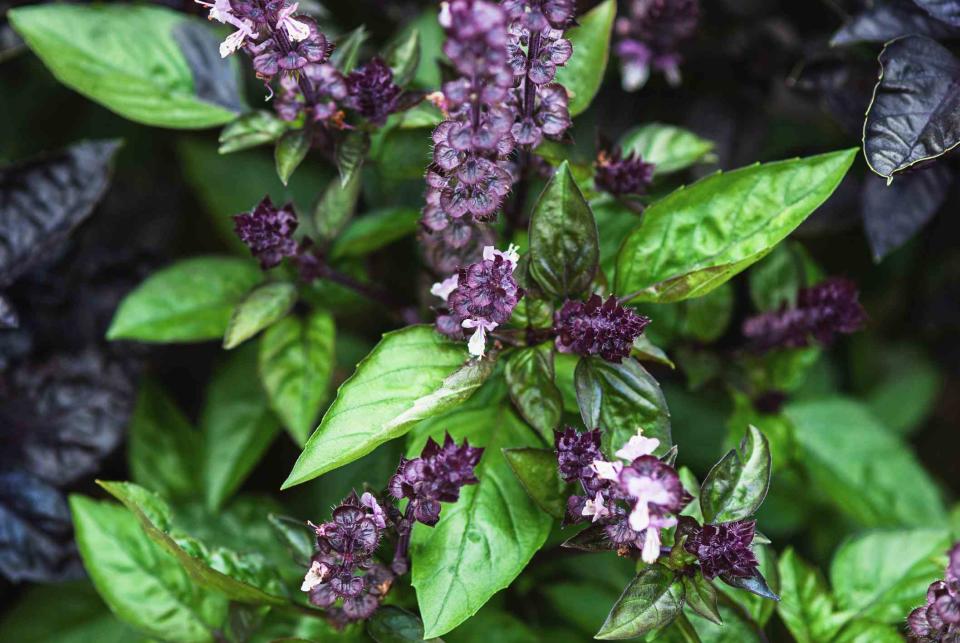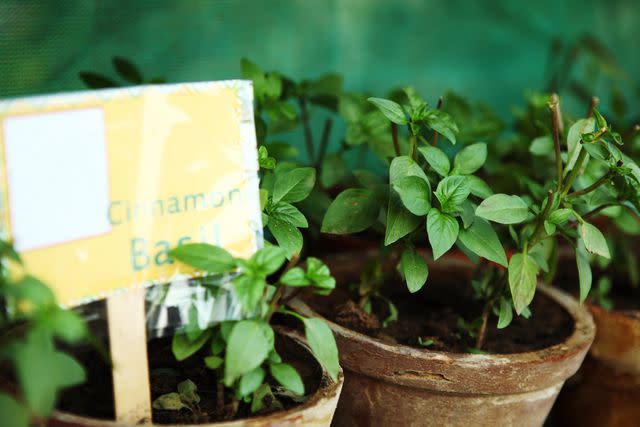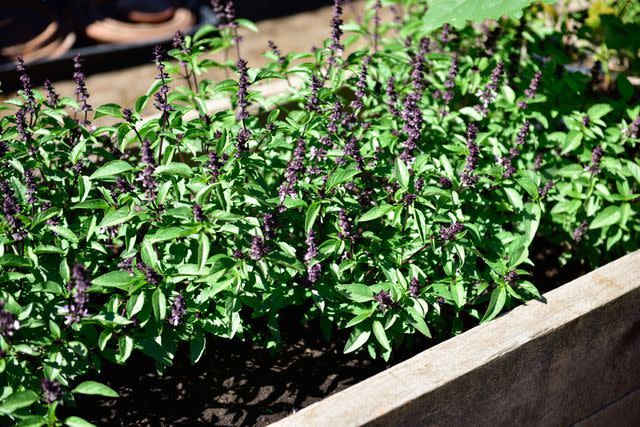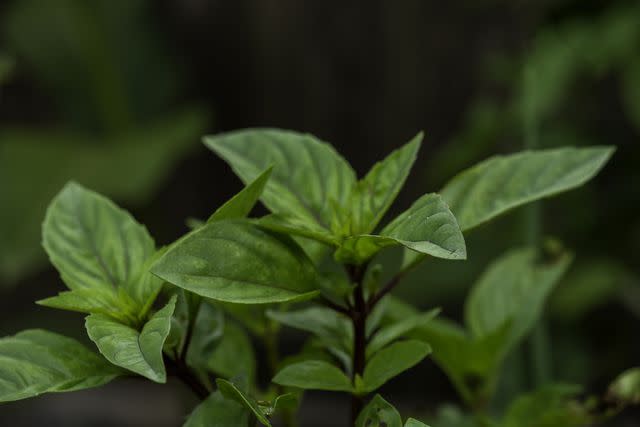How to Grow Cinnamon Basil for a Unique Herb Garden
Grow this spicy basil for a different take on classic basil

Nadya So / Getty Images
Cinnamon basil combines the flavor of traditional basil with that of sweet cinnamon, making it a perfectly unique addition to any herb garden.
This fast-growing type of basil has distinctive violet central stems with long, deep green leaves. If left unpruned, cinnamon basil turns into an attractive flowering plant with lavender-pink blooms.
Cinnamon basil grows up to 3 feet tall, but it can be kept much smaller for containers and limited space. In addition to being an attractive edible ornamental, its pest-repellant properties also make it an excellent companion plant for several popular garden crops, including tomatoes.
Common Name | Cinnamon basil, Mexican spice basil |
Botanical Name | Ocimum basilicum ‘Cinnamon’ |
Family | Lamiaceae |
Plant Type | Annual, herb |
Size | 18-36 in. tall, 12-18 in. wide |
Sun Exposure | Full sun |
Soil Type | Loamy, well-drained |
Soil pH | Acidic, neutral |
Hardiness Zones | 9-11 (USDA) |
Native Area | North America |
How to Plant Cinnamon Basil

danishkhan / Getty Images
When to Plant
Whether you plant nursery-grown basil or start your own plants from seed outdoors, you’ll need to wait until there is no further danger of frost, when temperatures are consistently above 70 degrees during the day and above 50 degrees at night. To get a head start on the growing season, start the seeds indoors about one month before your last average frost date.
For a constant supply of cinnamon basil, reseed it every four to six weeks.
Selecting a Planting Site
Find a location with full sun most of the day and fertile, well-drained soil.
Like with all garden crops, following crop rotation rules is key for healthy plants. Don’t plant basil in the same spot where you have grown basil or other members of the mint family (lavender, sage, rosemary, thyme, oregano, mint) in the past two or three years.
Spacing, Depth, and Support
Space the plants 8 to 12 inches apart.
Cinnamon basil has a strong central stem and does not require support. However, it does not compete well with weeds. Mulching around the plant helps to suppress weeds and preserves soil moisture.
Cinnamon Basil Plant Care
Light
Basil needs plenty of sunshine, between 8 and 12 hours of sunlight every day.
Soil
The soil should be moist, moderately rich, and well-draining, ranging from mildly acidic to neutral pH. If the soil is poor, amend it with organic matter before planting.
Water
Unlike herbs with thick leaves, basil needs moisture; it is not drought-tolerant and prone to damage under heat stress. In the absence of regular rainfall, water it deeply every week, more often during hot summer weather.
Temperature and Humidity
Cinnamon basil is a warm-weather plant that reaches its peak in the summer. It does not take a frost to make it unusable—in cool weather, the leaves turn black.
High humidity becomes an issue if the plants are crowded and there is not sufficient airflow.
Fertilizer
Although basil is harvested frequently, it needs only a moderate amount of fertilizer. For plants in the garden, applying a 5-10-5 once or twice during the growing season is sufficient. For potted plants, use a liquid fertilizer, diluted to half-strength, every four to six weeks. Too much fertilizer leads to rapid plant growth and diminished foliage flavor.
Cinnamon Basil vs. Thai Basil

Barbara Rich / Getty Images
What is commonly known as Thai basil in North America is sometimes also called cinnamon basil, leading to people wondering whether they are the same thing. They are not—cinnamon basil Ocimum basilicum ‘Cinnamon’ and Thai basil (O. basilicum var. thyrsiflora) are two different basil varieties.
Cinnamon basil has a distinctive cinnamon spice taste; it has a fresh, earthy aroma with no traces of anise. Thai basil, on the other hand, has a distinctive taste of black licorice or sweet anise and no hints of cinnamon.
The leaves are different, too. Cinnamon basil has narrower, more delicate, more serrated, and shinier leaves than Thai basil.
Companion Plants for Cinnamon Basil
Cinnamon basil makes an excellent companion plant for many garden crops because it deters pests such as aphids, thrips, tomato hornworms, and different flies, such as carrot flies and whiteflies. And it attracts beneficial pollinating insects, including bees and butterflies.
Good companions for basil include tomatoes, peppers, carrots, beets, garlic, lettuce, and asparagus. Other herbs, such as cilantro, dill, and marjoram, are equally good neighbors.
When planting basil next to garden crops, take into consideration the mature size of the neighboring plant and how it affects sun exposure. For example, a basil plant that is shaded by a tall tomato plant will do poorly.
Harvesting Cinnamon Basil
Cinnamon basil takes about 65 days from seeding to maturity, but you can start harvesting lightly after plants have become established. Using a sharp knife or scissors, cut off individual leaves at the tip of the stems or remove the entire stem tips with one or two sets of leaves.
Once the plant is full and bushy, it is also possible to harvest entire stems by cutting them just above a pair of leaves. Regular harvesting forces the plant to grow more leaves and prevents the formation of flowers. Once the plant has started blooming, the flavor becomes too strong.
The best time to cut basil is in the early morning; in cooler temperatures, it is less prone to wilting. Harvesting just before use is ideal. If you need to store it, keep it in a moderately cool place above 50 degrees F.
How to Grow Cinnamon Basil in Pots

Cinnamon basil makes an excellent container plant. Choose a container that is at least 6 inches in diameter and has large drainage holes and fill it with well-draining potting mix.
Because cinnamon basil gets quite big, and overcrowding leads to fungal problems, it is best to give the plant its own container or use a planter large enough to space the plants at least 12 inches apart.
Cinnamon basil in containers need more watering than plants in garden soil. Water whenever the top inch of soil feels dry. Repotting cinnamon basil during its single-season lifespan is not necessary.
Pruning
Harvesting basil regularly usually takes care of the pruning in one fell swoop yet there are some things to know about pruning cinnamon basil.
If you are growing cinnamon basil for culinary use, the goal is to get it to grow as many leaves as possible without flowering. Pinch off the central stem when the seedlings are about six weeks old, and be diligent to remove any flower buds as soon as you detect them.
If you are growing cinnamon basil as an ornamental, for its edible flowers, or as a pollinator magnet, there is no need to prune anything else but the central stem when the plant is about 6 inches tall to encourage branching. Left alone, cinnamon basil should flower by midsummer.
How to Grow Cinnamon Basil From Seed
The primary propagation method for cinnamon basil is to start it from seed either indoors or outdoors.
Start the seeds indoors about four to six weeks before your last average frost date.
Plant the seeds ¼ inch deeps in seed starting trays or flats filled with sterile potting mix.
Keep the soil evenly moist. At a temperature between 65 to 70 degrees, germination takes six to ten days.
The seedlings need plenty of sunlight; if you don’t have a south- or west-facing window, place them under grow lights for at least 8 hours daily.
Harden off the seedlings before transplanting them in the garden well after the last frost.
Follow the same directions for direct seeding outdoors after the last frost when the soil has warmed to at least 70 degrees F. Keep the soil evenly moist. When the seedlings are 2 inches tall, thin them so there is 8 to 12 inches between plants.
Overwintering
Like all basil, cinnamon basil is sensitive to temperatures below 50 degrees F. Most gardeners don’t bother protecting the plant from the cold because by the end of the summer or early fall, the plant has exhausted its energy reserves.
If your plant still looks vigorous and healthy when temperatures drop, you can try to extend its lifespan. Dig it up, plant it in a pot, and bring it indoors. Place it near a south- or west-facing window or under grow lights for at least 10 hours daily while keeping it evenly moist.
You might get a few more weeks out of it but even with the best care, the plant won’t last over the winter.
Common Pests and Plant Diseases
Basil is mostly unbothered by serious pests and diseases, but it can get fusarium wilt, gray mold, bacterial wilt, bacterial leaf spot, and downy mildew. In wet conditions, root rot may occur.
The most common pests of basil are aphids, Japanese beetles, and slugs. The application of insecticidal soap helps to control soft-bodied insects. Japanese beetles are best hand-picked and tossed in soapy water. Diatomaceous earth is effective against slugs, but it must be reapplied after a rainfall.
Frequently Asked Questions
Does cinnamon basil taste like cinnamon?
Both the spice and this variety of basil contain the chemical cinnamate, giving them their flavor. This basil gets its name because it contains the same ingredient as cinnamon: methyl cinnamate.
Does cinnamon basil come back every year?
It doesn’t. Like other basil types, cinnamon basil is a perennial that is grown as an annual whose life cycle ends with the onset of colder weather in the fall. Even when grown in a warm climate or brought indoors for overwintering, the plant has exhausted its reserves and typically dies over the winter.
Does cinnamon basil spread?
Cinnamon basil grows into a tall and bushy plant if you leave it unpruned, but it stays within its designated space and does not spread the way mint spreads by rhizomes.
Read the original article on The Spruce.

